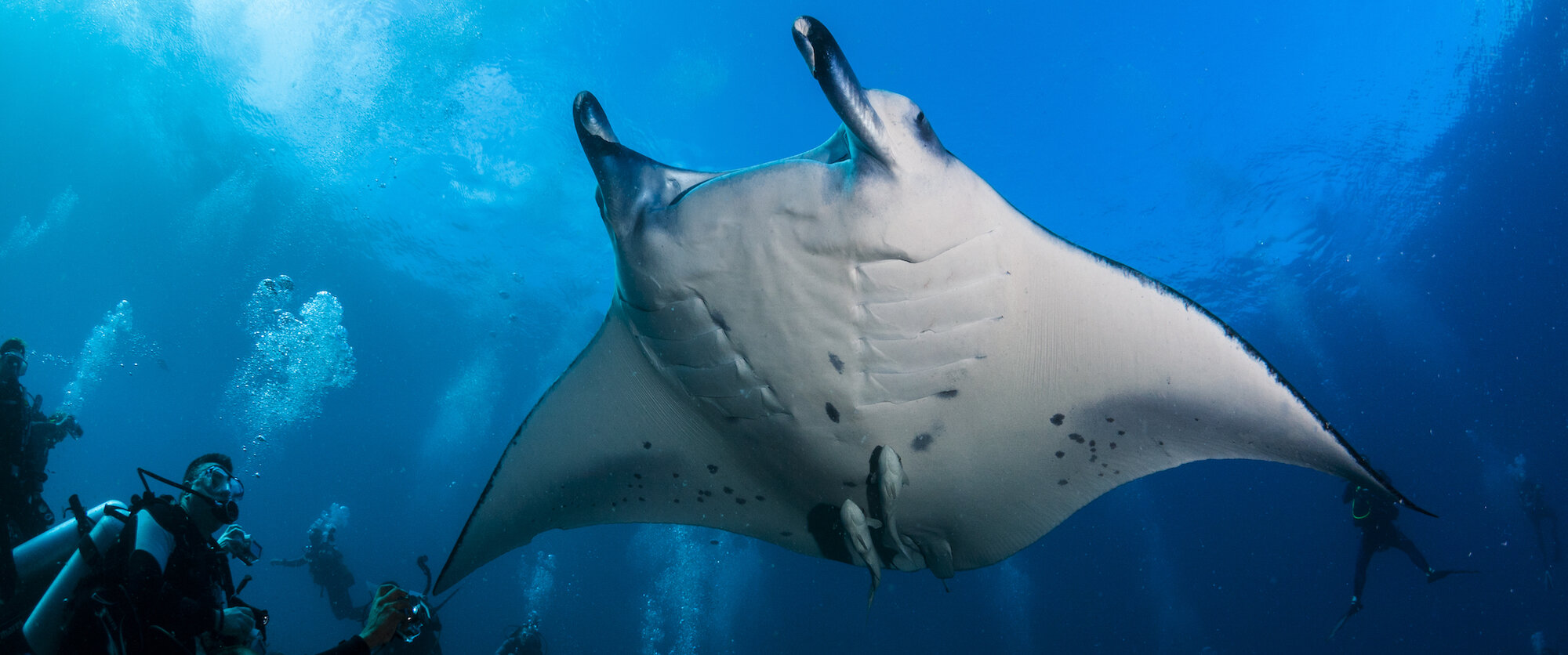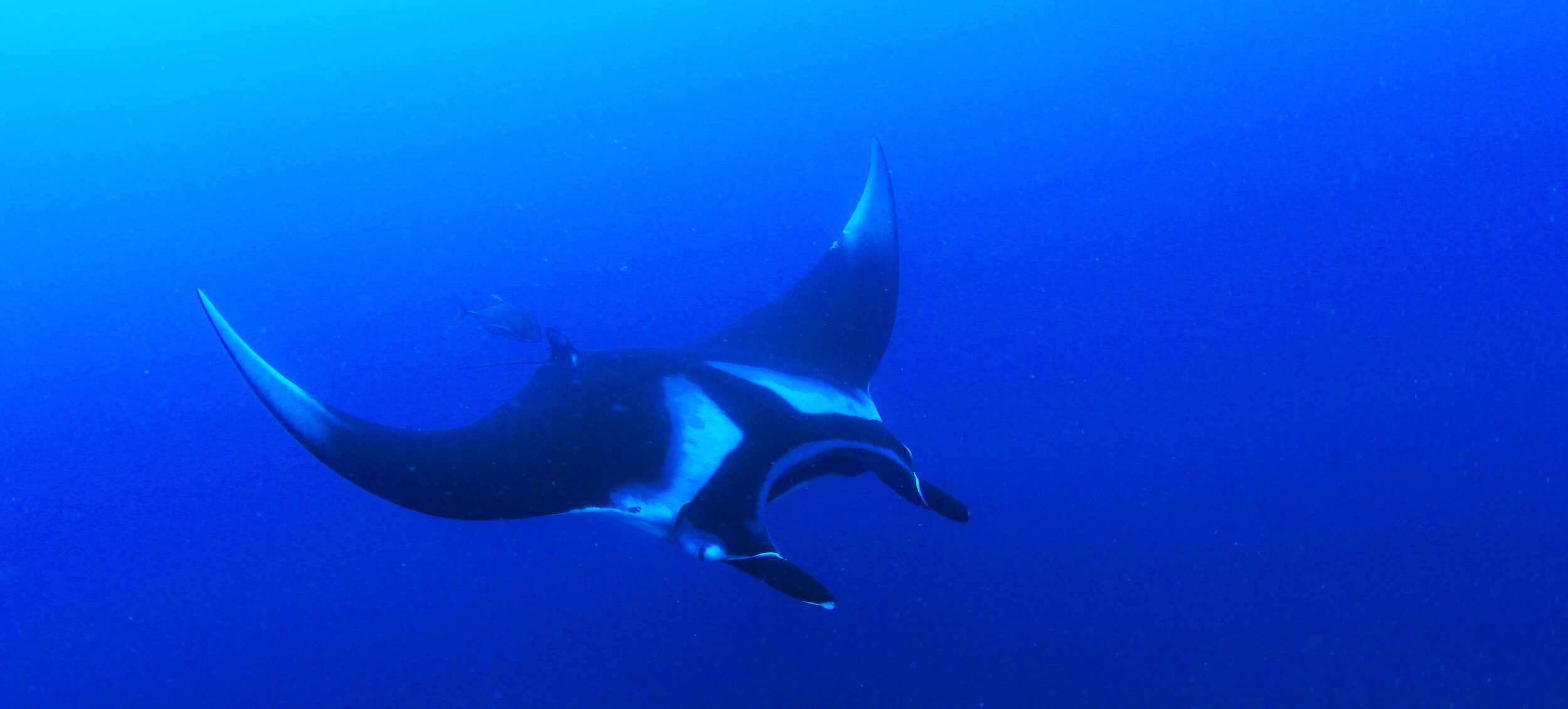
Swim with Manta Rays:
Best Encounters & Where to See Them

Encounter the majestic manta ray in its own underwater world.
Don’t travel to the wrong destination. Find the ultimate swimming with manta ray experiences guaranteed to be worth your time.
Best Places to Swim with Manta Rays
Manta rays are found across the tropics, favouring warm and rich waters with an abundance of plankton to feed on. While the giant oceanic manta ray scours the seas in search of food, reef mantas remain in select locations. The result is that you can swim with manta all around the world, but some places are better than others. Discover the best places to swim with manta ray.

Swimming with Manta Rays in The Maldives
Best time of year to swim with manta rays in the Maldives:
Year-round
The Maldives is known for being one of the best places on the planet to swim with manta rays. Drawn from across the vibrant Indian Ocean that surrounds them, you’ll find both giant manta and reef manta here, and plenty of them. The waters around The Maldives are known for being calm and sheltered, which makes this a prime destination for both diving and snorkelling.
Hanifaru Lagoon
A well-known feeding hotspot for manta rays, as many as 200 manta rays are spotted in Hanifaru Lagoon during peak season. Book in advance if possible, because this is a protected marine sanctuary. Diving is not permitted and snorkelling is tightly regulated.
Hurai Far
Close to Hanifaru is Hurai Far, another popular destination for manta ray in The Maldives. Hundreds visit these rich feeding waters throughout the year, and being a relatively small area, it becomes easy to spot the animals.
Addu Atoll
The southernmost collection of islands in The Maldives, Addu Atoll is undeniably the best place to swim with manta ray if you’re looking to dive. Here is where you’ll find the largest ocean-going manta rays, with wingspans over 5 metres!

Swimming with Manta Rays in Indonesia
Best time of year to swim with manta ray in Indonesia:
November to May
The country of Indonesia is a tropical archipelago that is home to exotic reefs and a treasure-trove of marine life. The result is a heaven for large filter feeders like manta rays, which is why Indonesia is one of the best countries in the world to swim with manta rays. A protected species in Indonesia, primarily due to their popularity with tourists, this is a great location for ethical encounters.
Bali
Bali is home to one of the famous manta ray cleaning stations, where large mantas congregate around reefs to be cleaned of parasites by fish. These spots are close to the surface, as the fish that clean them (wrasse) prefer shallower waters, making it a great location for both divers and snorkelers.
Komodo
The Komodo Islands are famed hosts of the Komodo dragon, yet there is much more to this wild paradise than a giant lizard. Isolated and protected, the waters around Komodo are stunning dive and snorkelling locations in their own right, but they really come to life when visited by manta ray. The ocean giants flock to the pristine waters between December and February. Note that to swim with manta ray around Komodo, you’ll need to opt for a liveaboard boat trip, usually lasting a few days.
Raja Ampat
Home to the fabled manta ridge, Raja Ampat is known for its amazing manta displays. Here to both feed and clean, they glide through the waters in large numbers. Whilst it is a great place to see manta ray, it can be a challenging dive due to underwater currents, so only a spot for experienced divers. The surface is much calmer, however, and perfect for all snorkelers.

Best Places to Swim with Manta Rays in Asia
Best time of year to swim with manta rays in Asia:
Dependant on Country
Indonesia and the Maldives are two fantastic countries to visit if you want to swim with manta rays. However, they aren’t the only locations in Asia that offer exciting opportunities for manta ray encounters. Across the continent, you’ll find numerous destinations that allow you to swim with manta ray.
Ishigaki, Japan
Ishigaki Island is a small Japanese territory actually much closer to Taiwan than Japan. It is famed for its golden beaches, but the real treasures of this island are below the surface. Colourful reefs draw a vast range of marine life, including manta ray. Two locations, in particular, are known for their manta ray congregate, dubbed Manta City and Manta Scramble for the sheer volume of animals that visit. Peak season is April to November, as manta rays head to Ishigaki for a good clean and rest.
Koh Bon, Thailand
Koh Bon is a phenomenal little island off the southern tip of Phuket, Thailand, that offers stunning snorkelling and diving experiences. Dozens of large giant oceanic manta rays swim around the coasts of Koh Bon close to the new year. It’s not fully understood why, as the feeding opportunities are not as rich as other locations. But, for whatever reason, the mantas arrive and provide swimmers with a chance to encounter the giant creatures.
Similan Islands, Thailand
The Similan Islands are a breathtaking archipelago off the coast of western Thailand. The vibrant reefs out in this secluded location really are a sight to behold, and if you venture a little further out into deeper waters, you’ve got a good chance of swimming with manta ray if you pick your dates right, which are between November and April.

Best Places to Swim with Manta Rays in America
Best time of year to swim with manta rays in America:
Year-round
Besides Antarctica, the continents of North and South America are the least densely populated landmasses on Earth, which means they are also home to some places of true wild isolation. The rugged landscapes of the land are reflected beneath the waves, and this cut-away nature means there are some truly amazing places to swim with manta rays.
Socorro Island, Mexico
Type Socorro Island into Google and you’ll be greeted by a massive image of a manta ray. Found off the coast of Baja California, a location well-known for its marine life, Sorrorco offers some of the best diving encounters anywhere in Mexico. A remote location, you can only reach it by liveaboard boat, but it’s worth the trip. Visit during the peak season of the winter months and you’ll not only see a wealth of feed manta, but many other giants including whales and whale sharks.
Isla de la Plata, Ecuador
A hive of underwater life, Ecuador’s coveted Isla de la Plata plays host to both species of manta ray (giant manta and reef manta) as they follow migratory paths along the coast, seeking plankton. This location is a little-known gem. Time your visit right, August to September and you might find yourself part of the largest congregation of manta rays seen anywhere on Earth. Many hundreds of manta visit over the course of just a few weeks.
Kona, Hawaii
Kona, a small town on the western edge of Hawaii, is perhaps the best place in the world to snorkel with manta ray. The reason is that manta rays here are drawn very close to the shore; so close you can often observe them from land. This puts them in shallow waters that makes visibility for snorkelers excellent. Kona night dives are also famous for being amazing opportunities to swim with manta ray, taking place a little further offshore.

Best Places to Swim with Manta Rays in Australia & South Pacific
Best time of year to swim with manta rays in the South Pacific:
May to September
The South Pacific is a region of the ocean that often goes unexplored due to its remote nature. The result is that this relatively untouched area of the world is alive with undersea life. Warm and rich seas provide the perfect feeding grounds for animals like manta rays. Some regions of the South Pacific offer the best opportunities to swim with manta ray anywhere the world.
Fiji
Fiji is a dream holiday destination for many, so why not improve on an already incredible experience with a manta ray encounter? During the manta ray season, the animals frequent the waters around the island almost every day. It is rare for you not to see manta ray here if you go to the right place. Manta Ray Passage, a channel between Naviti Island and Drawaqa Island that lie off Fiji’s northeastern coast, attracts manta ray in large numbers. Due to its unique ecological qualities, masses of plankton proliferate in the channel, which draws in the manta rays.
French Polynesia
You can swim with manta ray all around the islands of French Polynesia. Snorkelling is possible in the right places, but we do recommend diving when possible as there are lots of deep areas, such as Tiputa Pass on Rangiroa Atoll, where you can often see manta. Your best options will be to travel out on tours from Bora Bora, but really, pick anywhere in French Polynesia and you’ll have a chance of seeing manta rays. The waters are just so rich and full of life that they attract many hundreds of rays throughout the season.
Ningaloo Reef, Australia
You can swim with manta ray around Australia’s Ningaloo Reef at any time of year, but the best season is around June to September. Why? Because at this time the manta ray appear in high numbers and become a lot more curious. They seemed focused more on exploration and less on feeding. Just off Exmouth on the west coast of Australia Ningaloo Reef is very accessible and offers incredible encounters for divers and snorkellers.

Discover More About Manta Rays:
Before You Swim with Manta Rays: How to Swim with Manta Rays
Manta ray encounters are incredible and life-changing. But if not done properly and sustainably, they can have a detrimental impact on these beautiful animals. Manta rays are delicate and sensitive. For ethical encounters, you must treat them with care and respect. Learn to swim with manta ray the right way, and you’ll help support fantastic eco-tourism that benefits both man and ray.
Keep Calm and Quiet
Avoid splashing while entering or leaving the water, and while swimming maintain gentle and slow movements that mimic the peaceful motion of manta ray.
Keep Your Distance
Enter the water 10 meters from manta rays and remain at this distance unless they approach you.
Be Passive
Don’t enter the water in front of manta ray. Avoid physical contact. Be a non-disruptive presence manta ray can ignore if they wish to.
Be Patient
Allow manta ray to approach you. If they aren’t feeling curious, don’t chase them.
It’s also important to learn about local laws when swimming with manta rays. Every country has different rules. Learn them before you swim with manta ray.

How to Find a Reputable Tour Operator When Swimming with Manta Rays
You want to swim with manta rays in a way that doesn’t disrupt or distress them. Manta rays are intelligent and curious creatures. They can enjoy an encounter with people if it’s done properly. But how do you make sure that’s the experience you have?
Check Certifications
Does the manta rays tour operator have links to charities or reputable establishments? Check to see if they work with biologists, non-profits and researchers.
Check Reviews
Look for warning signs. Some may be obvious, with people stating unethical practice, others less so. Look for first-hand encounters that offer red flags, like getting too close, even if the review is positive. (The reviewer may not care about manta ray welfare)
Check Social Media
Found pictures of large swimming groups, people touching manta ray, or posts that offer promises of guaranteed close encounters? Avoid.

